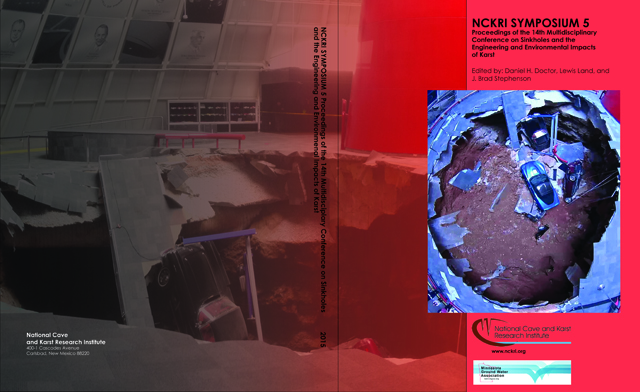Abstract
Residential building construction along the Mississippi River bluffs in the 1970s created a unique enclosed outcrop of the Late Ordovician Platteville Formation at Lilydale, Minnesota. This outcrop was examined in early 2013 after a newly-formed spring flooded an elevator shaft the previous year, drawing attention to the foundation conditions. The Lexington Riverside property is a six story condominium complex constructed within the top of the bluff. A two-level underground parking garage was built into the bluff. Bedrock was mechanically excavated to accommodate the construction of the building, creating an unweathered rock surface. The space between the structure and the excavated rock face, running for 150 meters, was roofed over, and is used as a utility space. At least three dominantly carbonate members of the Platteville Formation are visible: Mifflin, Hidden Falls, and Magnolia, in ascending order. The foundation of the structure was constructed on the lowermost Platteville limestone and Glenwood shale and is tile-drained to the nearby river gorge. Most of the seeps and springs on the property, both inside and on the grounds, belong to the three Platteville spring-lines identified for the Twin Cities Metropolitan (TCM) area by Brick (1997). Groundwater emanates from both vertical joints and horizontal bedding plane partings within the Platteville limestone and at the Platteville–Glenwood shale contact. Overall, the hydrostratigraphic attributes of this site are consistent with how the Platteville has been recently characterized in the TCM area in a fractured bluff edge setting (Anderson et al., 2011). The enclosed outcrop features many seep- and spring-related mineral deposits. Most notable were the iron-stained flowstone and microgours near the seeps and springs along fractures in the limestone, and calcite rafts on the surfaces of the pools. At some damp locations a fungal ecosystem has developed. Gypsum beards have grown in dry portions of the cavern. This man-made cavern, and others nearby, present unique opportunities to research groundwater flow in fractured bedrock settings. Studying the spring locations relative to joints and bedding, changes in spring flow rate over time, and mineral deposition rates, are possible in this accessible location without the complication of surface water inputs or instrumental interference from the general public.
DOI
http://dx.doi.org/10.5038/9780991000951.1100
Included in
Construction Engineering Commons, Environmental Indicators and Impact Assessment Commons, Environmental Microbiology and Microbial Ecology Commons, Geology Commons, Geotechnical Engineering Commons, Hydrology Commons, Stratigraphy Commons
Seeps and Springs at a Platteville “Observatory” on the River Bluffs
Residential building construction along the Mississippi River bluffs in the 1970s created a unique enclosed outcrop of the Late Ordovician Platteville Formation at Lilydale, Minnesota. This outcrop was examined in early 2013 after a newly-formed spring flooded an elevator shaft the previous year, drawing attention to the foundation conditions. The Lexington Riverside property is a six story condominium complex constructed within the top of the bluff. A two-level underground parking garage was built into the bluff. Bedrock was mechanically excavated to accommodate the construction of the building, creating an unweathered rock surface. The space between the structure and the excavated rock face, running for 150 meters, was roofed over, and is used as a utility space. At least three dominantly carbonate members of the Platteville Formation are visible: Mifflin, Hidden Falls, and Magnolia, in ascending order. The foundation of the structure was constructed on the lowermost Platteville limestone and Glenwood shale and is tile-drained to the nearby river gorge. Most of the seeps and springs on the property, both inside and on the grounds, belong to the three Platteville spring-lines identified for the Twin Cities Metropolitan (TCM) area by Brick (1997). Groundwater emanates from both vertical joints and horizontal bedding plane partings within the Platteville limestone and at the Platteville–Glenwood shale contact. Overall, the hydrostratigraphic attributes of this site are consistent with how the Platteville has been recently characterized in the TCM area in a fractured bluff edge setting (Anderson et al., 2011). The enclosed outcrop features many seep- and spring-related mineral deposits. Most notable were the iron-stained flowstone and microgours near the seeps and springs along fractures in the limestone, and calcite rafts on the surfaces of the pools. At some damp locations a fungal ecosystem has developed. Gypsum beards have grown in dry portions of the cavern. This man-made cavern, and others nearby, present unique opportunities to research groundwater flow in fractured bedrock settings. Studying the spring locations relative to joints and bedding, changes in spring flow rate over time, and mineral deposition rates, are possible in this accessible location without the complication of surface water inputs or instrumental interference from the general public.

